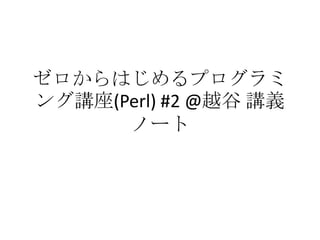
ゼロからプログラミング講座(Perl) #2 @越谷 講義ノート
- 1. ゼロからはじめるプログラミ ング講座(Perl) #2 @越谷 講義 ノート
- 2. 配列を思い出す • 配列の定義のしかた 配列の基本は、全体を「丸いカッコ " ( " と" ) "」で 囲う。中の要素は、文字列ならシングルクォート ( ' )で囲う。ダブルクォートで囲ってもいいけ ど、それを使うのは、変数展開をするときに適し ている。数字なら、クォートで囲う必要はない。
- 3. • 配列の基本形 - 配列のシジルは@ @eras = ('明治', '大正', '昭和', '平成'); • 別にダブルクォートで文字列を囲んでも いい @eras = ("明治", "大正", "昭和", "平成");
- 4. この他に、カッコやクォートを書くのがめんどく さい場合に、qwというのがある。 カッコやクォートを書くのがめんどくさかったら @eras = qw/明治 大正 昭和 平成/; @eras = qw!明治 大正 昭和 平成!; @eras = qw{明治 大正 昭和 平成};
- 5. qw は quote words の略で、words(単語)をクォー トして(囲って)ね、という意味。普通は、qw/ 単語1 単語2 単語3../と、始まりと終わりをスラッ シュ( / )でくくるけど、ここの文字は他の文字 でもよい。例えば、 | とか ! とか # とか $ とかでも OK。かなりいろいろな記号が許容される。また、 4種類のカッコのペア () と{} と [] と <> でもよい。 この qw// の記法はクォートとカンマを省略できる メリットの他に、もう一ついいことがあって、そ れは、クォートの記号のエスケープをしなくてす むというところ。
- 6. 例えば、「明治」という単語の中が、(なぜか) 「明'治」となって、「明」と「治」の間に、シン グルクォートが入っていたとしよう。それを配列 に入れようとすると、「明」と「治」の間のシン グルクォートは、単語をくくっているクォートと は別なんだよ、と示すために、前にバックスラッ シュ(円マーク)をつけないといけない。(下記 のように) @eras = ('明¥'治', '大正', '昭和', '平成');
- 7. これを、「エスケープする」というのだけど、こ ういうことが増えてくると、くくるためのクォー トなのか、単語の中に(たまたま)含まれている クォートなのかを判別して、エスケープしていく のが、煩雑になってくる。 しかし、qw// の場合は、くくる文字がシングル クォートではないので、エスケープする必要が生 じない。 @eras = qw/明'治 大正 昭和 平成/;
- 8. じゃあ、文字の中にスラッシュ( / )が入ってし まったら?そうしたら、 / 以外の文字でくくって やればいい。 @eras = qw!明'治 大/正 昭和 平成!; このように、エスケープする必要が生じたら、そ れをしなくていいように囲う文字を造作もなく変 えることができるので、 qw// は便利なのである。
- 9. 配列の要素を呼び出すには 配列は、何番目の要素かを指定してやることで、 その要素を呼び出すことができる。 たとえば、 print "$eras[0] ¥n"; # 「明治」とでてくる 注意しなくてはいけないのは、最初の要素は1番目 ではなく、0番目であるということ。それから、添 字は [ ] という角カッコで囲むこと。(違うカッコ の形、たとえば { } だと違う意味になってしまい NG)
- 10. 表示するのは、 print "$eras[0] ¥n"; # 明治 print "$eras[1] ¥n"; # 大正 print "$eras[2] ¥n"; # 昭和 print "$eras[3] ¥n"; # 平成 とやればいいけど、もっとたくさんの要素数に なったら大変。どうする?→ループを使おう
- 11. for文 • C言語っぽい書き方 # はじめ おわり 1ステップ進んだら for ( $i = 0; $i < 4; $i++ ){ print " $eras[ $i ] ¥n "; } for ( 条件式 ){ ループ1回の処理内容 }
- 12. 最初の $i = 0 は、$i という変数を 0 という値 にしていて、初期化の意味合い。2番目は、 このループが継続される条件を示していて、 この場合だと、4より小さければ続行。3番 めの $i++ は $i を1増やすという意味。ちな みに、$-- は1減らす。
- 13. このループを日本語にしてみると、 最初は $i は 0 $i は 4より小さいので { } の処理をする 終わったら $i を 1増やす→ $i は 1 になった! ループの先頭に戻ってくる いま $i は 1 で、 4より小さい→ループ続行 { } の処理をする 終わったので $i を 1 増やす→ $i は 2 になった! ループの先頭に戻ってくる (中略) $i を 1増やす→ $i は 4 になった! ループの先頭に戻ってくる いま $i は 4 で、 4より小さくない!→ループ終了 という感じである
- 14. { } の中では、条件式で使った $i を使用している。 print " $eras[ $i ] ¥n "; これは、 $i 番目の添字の要素を表示するという意 味になっており、$i は1ずつ増えていくので、 ループがまわるごとに1個ずつ要素が表示されて いくことになる。
- 15. foreachを使うやり方 C言語ライクなfor文は、配列の添字を1個ずつず らしていくことで、 一個ずつ配列の要素を取り出 していく方法だった。 この方法だと、添字( $i ) をわざわざ用意して、それを一個ずつ増やしてい くという ことをしなくてはならないし、 添字の始 まりはいくつで、終わりはいくつという”境界条 件”について、 考えなければ書くことができな い。
- 17. foreach $jidai ( @eras ){ print $jidai, "n"; } #解説 foreach 要素 ( 配列 ){ ループ一回分の処理 }
- 18. 配列という入れ物の中から、要素を一個ずつ取り 出していって、 中身がなくなったらそれで終わ り、というイメージである。 わざわざ始まりと終 わりを指定するコードを書かないで済むので、 個 人的に書いていて楽だと感じる。 今回は、@erasから要素を一個取り出したら、 $jidaiという変数でそれを受け取ったが、 変数名は 自由につけて構わない。
- 19. ちなみに、要素を受け取る変数名は、省略してし まってもいい。 その場合は、「 $_ 」という特殊 変数に要素がセットされる。 foreach ( @eras ){ print $_, "n"; }
- 21. print 'Born year?:'; $b_year = <STDIN>; chomp( $b_year); if( $b_year < 1989 ){ print "Showa!n"; }else{ print "Heisei!n"; }
- 22. 最初は、「生まれた年は?」と聞いてるつもり で、「Born year?」と表示し、 その直後で、入力 を受け付けるようになる。()受け取った入力の 改行コードを削るのが chomp($b_year) で、このあ たりは第一回でやったのでそちらを参照してほし い。 $b_year という変数に何年生まれかの数字(おそら く19ではじまる4桁の数字)が格納されていて、 それが if文 の条件式にはいる。
- 23. if( $b_year < 1989 ){ print "Showa!n"; } 「 $byear < 1989 」は$byearの値が1989よりも小さ い、という意味で、 この式が正しければ、つま り、$b_yearに入っている数字が1989より小さけれ ば、 そのあとの { } で囲まれたブロックが実行され る。今回は、単純に「 Showa!」と表示するだけで ある。 if文 は、単にこれだけでも成立する。
- 25. 今回は、1989以上の数字が入力された場合は、「 Heisei! 」 と表示するようになっている。 if( $b_year < 1989 ){ # 1989より小さかったら print "Showa!n"; # 昭和! }else{ # そうじゃなかったら print "Heisei!n"; # 平成! } このように、if文はelseと同時に使うことが多い。 そして、もう一つ、if と else の他に、 elsif というものがあ る。
- 26. elsif 注意点は、「 elseif 」でも「 else if 」でもなくて、 「 elsif 」だということである。 先の、 if - else の場合は、「条件Aが真ならばこれ これ、そうでなければそれそれ」、という二者択 一的な分岐だった。elsifを用いると、「条件Aが真 ならばこれこれ、(条件A、は真ではないけど)条 件Bが真ならばあれそれ、そうでなければそれそ れ」と分岐の選択肢を増やすことができる。
- 27. 1989年に生まれた人は、生まれた日によっては、 平成生まれかもしれないし、昭和生まれかもしれ ないので、もし、1989と入力されたときは、即 「平成!」とレッテルを貼るのは不正確である。 ということで、以下のように修正をした。 if( $b_year < 1989 ){ print "Showa!n"; }elsif($b_year == 1989){ print "Showa or Heisei!n"; }else{ print "Heisei!n"; }
- 28. 今度は、 elsif( $b_year == 1989 ) という条件が加 わった。今度は、$b_yearが1989に一致したら、と いう意味になる。イコールが2つつながる( == ) と数字として一致するという意味になります。 「 $b_year == 1989 ($b_yearが1989と一致するとい う条件式)」と「 $b_year = 1989 ($b_yearに1989 という値を代入)」は「 = 」が一個あるかないか の違いしかありませんが、意味がまったく違うの で、注意しましょう。
- 29. 練習:for文とif文を組み合わせ る 配列の宣言の仕方として、 こんなのもあります。 @years = ( 1970 .. 2013 ); #上は下と等価 @years = ( 1970, 1971, 1972, 1973, (中 略), 2010, 2011, 2012, 2013 )
- 30. 1970 .. 2013 と書くことで、1970から1ずつ増やし て2013までの連続した数字の配列をあらわすこと ができます。何十もの要素をもつ配列ですが、こ んなに簡単に表現できてしまいます。 これを使って、 1970年から2013年までを1年ずつ 表示し、それが平成か昭和か判定するプログラム を書いてみます。
- 31. @years = (1970..2013); for $y ( @years ){ if( $y < 1989){ print "$y : Syowa !n"; }elsif( $y == 1989){ print "$y : Syowa or Heisei !n"; }else{ print "$y : Heisei !n"; } } forのブロックの中に、if文で条件分岐し、条件ごとに違っ た文字列を出力しています。 自力で書くことができたで しょうか?
- 33. %era_year = ( 'Heisei' => 1989, 'Syowa' => 1926, 'Taisyo' => 1912, 'Meiji' => 1868 ); これは見やすくするために、複数行にわけて書い ていますが、一行にしてしまっても構いません。
- 34. また、キーとバリューを結ぶ記号として「 => 」を 使っていますが、 実は、単にカンマでもOKです。 奇数目の変数がキーで偶数目がバリューだとPerlは 解釈できるからです。しかし、人間の目にはわか りずらいので、たいていは「 => 」を使って書きま す。 #一行にしちゃってもOK(でも見にくい) my %era_year = ( 'Heisei' => 1989, 'Syowa' => 1926, 'Taisyo' => 1912, 'Meiji' => 1868 ); # => 使わなくてもOK(でも見にくい) my %era_year = ( 'Heisei', 1989, 'Syowa', 1926, 'Taisyo', 1912, 'Meiji',
- 35. キーは文字列なので今回はシングルクォートで囲 んでいますが、 ダブルクォートで囲んでもいいで すし、 実は文字列が一定の条件(ハイフンをふく まないなど)をみたせば、 クォートを省略するこ とができます。 Perl は => という記号を目印に、そ の左側は文字列であると判断できるからです。 バリューの方は、その変数の性質(数字なのか文 字列なのかオブジェクトなのか変数なのか)に よって、適切にクォートをつけたりしてください。
- 36. ハッシュとfor文を組み合わせる練 習 今度は、ハッシュと先ほど練習したfor文の練習で す。 「(年号)は(西暦)年から始まります」 という文を、次々に表示するコードを書いて下さ い。 ハッシュのキーは keys という関数を使うと、キー だけを一括して取り出し、配列にすることが出来 ます。 そのキーの配列をfor文で回して、ハッシュ
- 37. @era = keys %era_year; for $jidai (@era){ print "$jidai は $era_year{$jidai} にはじまりま す。n"; }
- 38. use strictとmy ここまでやってきて、プログラムが動かない!という場面 に何度も遭遇したと思いますが、変数名を打ち間違えてい たというケースがけっこう多かったように見受けられま す。 例えば @era と書くところを @ear と書いてしまったり、 $eras[$i]と書くところを@eras[$i]と書いていたり。 そのようなたかが1文字違うだけでも、Perlはまったく違 うものとして扱うため、プログラムは止まってしまいま す。そして、人間の目には1文字の違いは見落としがち で、なぜプログラムが動かないのかわからずに煩悶しがち です。
- 39. そういうミスを回避するために、「 use strict; 」を 使います。 use strictを使うと、変数は、使う前にあらかじめ 宣言することが必要になります。use strictの使い 方は、単に、ファイルの中に 「 use strict; 」と一 行書くだけです。各場所はどこでもいいのです が、たいていはソースコードの一番上、シバン行 のすぐ後に書きます。
- 40. #!/usr/bin/perl use strict; my $words = 'Hello, World'; print $words, "n";
- 41. 上のコードでは、 $words という変数の前に my と いうものがくっついていることに気づいたと思い ます。 my を変数の前に書くと、「この変数名をこれから 使います!」という宣言になります。「私の」と いう意味のmy です。(似た言葉に our がありま す) 先ほどのハッシュのコードは、use strictすると、 下記のように書かないと動きません。
- 42. use strict; my %era_year = ( 'Heisei' => 1989, 'Syowa' => 1926, 'Taisyo' => 1912, 'Meiji' => 1868 ); my @era = keys %era_year; for my $jidai (@era){ print "$jidai は $era_year{$jidai} にはじまります。n"; }
- 43. こうすると、何が嬉しいのでしょう? my という 文字を打つ手間が増えるだけじゃないかと思うか もしれませんが、そうではありません。 use strictすると、宣言をした変数しか使えなくな るため、 @eraと書くべきところで @earと書いて しまったら、Perlがエラーメッセージを吐いてくれ るようになります。 @eraは宣言されていますが、@earは宣言されてい ません。なので、宣言されていない @earが突然で てきたら、Perlは、「そんな変数を使うなんて聞い てない」とプログラムを停止し、エラーを出力し ます。
- 44. そのようにエラーがでてくれば、プログラマは、 すぐにどこかでミスをしたことに気付くことがで きます。もし use strict をしていないと、@earと書 いてあっても、ひとまずはプログラムが止まるこ となく動いてしまうので、プログラマはミスに気 付くのが遅くなります。 use strictすると、他にもいろいろと"厳しく"なるの ですが、その厳しさは、どれもプログラマを助け てくれるためなので、今後はuse strict; を必ず書く ようにして、変数には my をつけて宣言してから 使うようにしましょう。
